Top 10 Plants and Creatures with the Most Painful Bite or Sting
This list focuses on plants and creatures with the most painful bites/stings.
Known as the dendrocnide moroides, the gympie gympie is a sacred plant found in Australia, and has heart shaped leaves.
It even grows fruits.
And while it looks like a normal plant, it's not something you want to mess with.
A sting by this contains venom known as moroidin, which is known to cause pain that is like being burnt with hot acid and electrocuted, and some have compared it to a giant squashing them, and workers without protection have experienced severe irritation, along with nosebleeds, swelling, rashes, and even severe allergies.
Yet the spines that inject it are microscopic and sink into skin, yet are extremely stable for years, yet the spines are made of silicon, causing years of pain, and it even recurs every time you take a shower.
There have been stories of victims killing themselves to escape the pain, which is why this plant is nicknamed the suicide plant.
Yet despite all the nasty effects, caterpillars seem to be immune to its stingers and eat the plant.
This alone is something that might keep you from ever wanting to set foot in Australia.
Plus, the treatment for this is to pour water with 10% hydrochloric acid on the stung area to break down the silicon spines and strip it off with tape or hot wax.
Yet if you think that sounds bad, it seems you problably won't notice increased pain as the pain of the actual sting is overwhelming and engulfing.
After all it's 10x worse than anything else, and is the king of sting as far as we know.
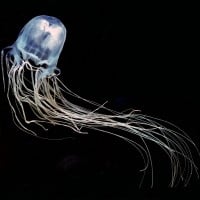 Box jellyfish are cnidarian invertebrates distinguished by their cube-shaped medusae. Some species of box jellyfish produce extremely potent venom: Chironex fleckeri, Carukia barnesi and Malo kingi.
Box jellyfish are cnidarian invertebrates distinguished by their cube-shaped medusae. Some species of box jellyfish produce extremely potent venom: Chironex fleckeri, Carukia barnesi and Malo kingi. The box jellyfish is found in Australia and it's sting is undeniably painful, as it fires nematocysts from its tentacles onto the victim's skin, causing searing pain that lasts for days to weeks on survivors, and causes paralysis, stomach ache, headache, fever, dizziness, nausea, low blood pressure, tachycardia, severe cramps, and in the worst cases, death.
Yet it's the most venomous animal at sea, and there's a subspecies called the irukandji, whose much smaller than other types of box jellyfish and has a sting who's full reaction is delayed by 20-30 minutes and slowly builds up, creating all those conditions in the form of irukandji syndrome, and no painkillers help and survivors must ride it out.
Victims tell nurses to kill them because the pain is extreme and they moan in agony even when unconscious because of the pain being unimaginable.
It's something you don't wanna mess with and something you'll never forget.
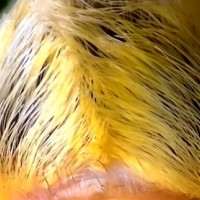
The Megalopyge opercularis has many nicknames, such as the fire caterpillar in the OSA peninsula, the furry puss caterpillar (as it looks like a cat), puss moth, asp in Texas and Italy, woolly slug, and are found in the OSA peninsula, Costa Rica, Brazil, the U.S. and Europe.
They're also seen in the U.S. and their cuddly looks hide a dark secret, their furry appearance is made up of urticating hairs that'll cause severe irritation on people in contact, and worse is that beneath those hairs are venomous spines, and if you get a bunch of these, then for 12 to 120 hours, you'll be in excruciating pain that resembles broken bones or blunt force trauma combined with being burned.
Yet the pain radiates throughout a large area and sometimes your whole body, and other effects include swelling, nausea, headache, abdominal pain, tachycardia, rashes, blisters, and sometimes chest pain, numbness, or difficulty breathing, yet many victims are wound up to the ER after a sting from these.
It's said the best treatment is to use tape or wax to strip the hairs and spines off (as the hairs and spines break off onto the victim after contact), and then use baking soda and antihistamines to relieve the itching and burning, though time is the best method, so you'd have to ride it out for the full pain to subside.
There were stories that the pain from these stings surpasses that of the sting/bite of any wasp, ant, scorpion, snake, spider, and even jellyfish, which means it's rumored to be the record for stinging creatures.
It's something that tells you don't judge a book by its cover, because it hides perhaps the worst nightmare for people afraid of stinging creatures.
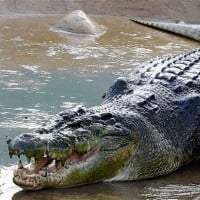 Crocodiles (family Crocodylidae) or true crocodiles are large semiaquatic reptiles that live throughout the tropics in Africa, Asia, the Americas and Australia. The term crocodile is sometimes used even more loosely to include all extant members of the order Crocodilia, which includes the alligators... read more
Crocodiles (family Crocodylidae) or true crocodiles are large semiaquatic reptiles that live throughout the tropics in Africa, Asia, the Americas and Australia. The term crocodile is sometimes used even more loosely to include all extant members of the order Crocodilia, which includes the alligators... read more They're known to bite defensively with extreme force, at 3,700 pounds per square inch (psi) or 16,640 newtons, biting through every tissue and even bone.
Plus they're more afraid of us than we are of them.
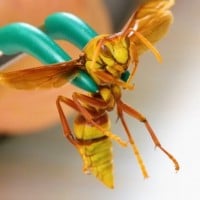
The polistes carnifex or executioner wasp is the largest neotropical paper wasp in the world, and is noted as having amongst the most painful of all known stinging insects.
It's 1.5" long and is yellow with coppery stripes, yet is named because it kills caterpillars and chops their heads off before taking them to their children.
A lucky encounter with one has been shown to have quite an extreme surprise on victims, as YouTube wildlife star Coyote Peterson found out the hard way.
On his experience with the executioner wasp showed it's sting is FAR more painful than the longtime previous record known for years, the bullet ant, and also more extreme than the sting of the infamous Japanese giant hornet, and the pain lasts for 36 hours with strong residual effects lasting almost a week, and while it's not known to cause extreme swelling, it's known that its venom burns a hole in the affected area due to the necrotic proteins.
It's been said it's sting rivals the bite of any centipede if a victim's given a full dose of its venom, proven by the fact that just the tiniest nick from its stinger leads to unimaginable pain and agony that lasts 36 hours and residue lasts for almost a week.
Which Coyote Peterson described as "flesh peeled back", which sounds like an ancient execution method called skinning (executioner wasp, great coincidence).
While there's no known human deaths following a sting, it's shown that it's venom is the most damaging of any known insect.
Yet it's something you'll never forget.
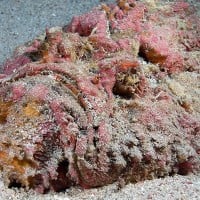 Synanceia is a genus of fish of the family Synanceiidae, the stonefishes, whose members are venomous, dangerous, and even fatal to humans. It is one of the most venomous fish known. They are found in the coastal regions of the Indo-Pacific.
Synanceia is a genus of fish of the family Synanceiidae, the stonefishes, whose members are venomous, dangerous, and even fatal to humans. It is one of the most venomous fish known. They are found in the coastal regions of the Indo-Pacific. The stonefish is found in Australia's coasts and is named because of its stone like appearance, yet it camouflages to hide from prey before ambushing them.
A sting from it injects venom that causes a pins and needles sensation at first, then tingling and becomes cramping like never before and then when you think the cramps are at the worst, a stabbing sensation is felt and is extreme and radiates deep into the affected limb or body part, and you feel also like you're being sledgehammered and kicked in the kidneys.
The pain is so extreme that victims vomit and even pass out, yet they want their limbs cut off, so it's extremely brutal.
Not only that, a sting from one even causes nausea, dizziness, paralysis, tachycardia, low blood pressure, seizures, uncontrollable drooling, even in worse cases cardiac arrest and even death if not treated properly.
There's a ritual where a dancer acts like a victim and falls to it's death, which tells you how serious these things are.
Yet not to mention they even survive and camouflage in sand and once someone gets too close, they fire their stinger at them abmush style.
It's a creature that's like a living nightmare in your imagination.
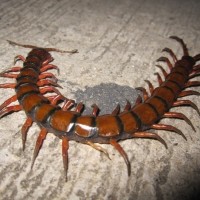
Known as scolopendra gigantea, they live in the Amazon rainforest and grow up to 30 cm, making them the largest centipedes in the world, yet their bites are known to be extremely potent as bites go, likely the most painful bites in the Animal Kingdom.
Worse than any snake or spider bite in pain, it would make the stings of bullet ants (which feel like gunshot wounds and are nearby and used by 12 year old boys in manhood initiation rituals) feel like fire ant stings, which are really nothing in comparison.
Yet Coyote Peterson, who bit himself (twice) with the giant desert centipede (scolopendra heros), which grows to 20 cm, said it makes a bullet ant's sting feel like a honeybee sting, and he said it was past his pain tolerance (which is MUCH higher than the average person's) and that he almost vomited, and if that centipede's bite sounded extreme, this would've surely made him (and you) vomit and even pass out from the unbearable pain.
If the giant desert centipede's bite felt like shoving a hot poker into your arm, then the bite of the Amazonian giant centipede must feel like pouring lava into your arm, which is just ridiculously painful, enough to be up here.
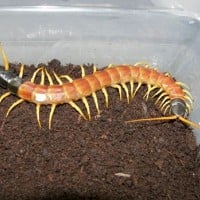
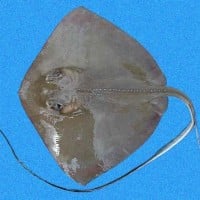
The creature that killed Steve Irwin with a sting in the heart is usually not very aggressive to humans, but they won't hesitate to sting you if threatened.
A sting from it involves a stab at the beginning along with bleeding, and while the initial stab is painful, it's nothing compared to the true onset of pain that comes.
It injects neurotoxins and the full reaction is delayed, and once it sets in, it's extremely painful, agonizing and worsens over hours, yet even causes severe cramping, muscle spasms, swelling, nausea, dizziness, and on occasions, death.
To remove the stinger requires surgery and it's barbed, so it breaks off the tail once it lands on you.
Not only that, but like a cat scratch, it contains a lot of bacteria and can make you very sick, possibly to the point of death.
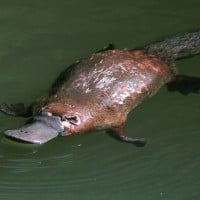 The platypus, also known as the duck-billed platypus, is a semiaquatic egg-laying mammal endemic to eastern Australia, including Tasmania.
The platypus, also known as the duck-billed platypus, is a semiaquatic egg-laying mammal endemic to eastern Australia, including Tasmania. Found in Australia, the platypus has the beak of a duck and the tail of a beaver.
It looks cute and all, but don't be fooled, the males have a spur on the ankle that delivers venom to its prey.
While there are not known to be human deaths, or even damage, it's venom is known to cause extreme pain that can hardly be described and incapacitate a human for days to weeks, or even months.
While there are creatures with more painful bites/stings out there, this is surely a big deal.
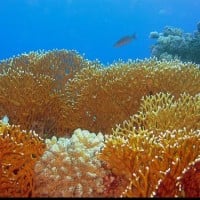
The fire coral is actually a hydrozoa, so it relates to the Portuguese man-o-war (which is often confused as a type of jellyfish).
It uses nematocysts to fire at prey, delivering venom that causes extreme pain, combined with rashes, along with swelling of the lymph glands and occasionally nausea and vomiting.
Yet depending on how much contact, pain can become out of this world, which resembles fire (hence its name, also from the color).
Like the rest of coral reefs, it's in danger from dying as humans keep messing up our climate.
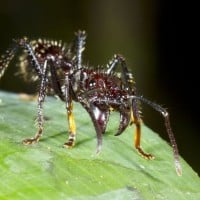
The bullet ant shouldn't be 14.
It's painful, but not enough to be up there.
It's nicknamed Paraponera clavata, and it's called the bullet ant because it's sting is said by many to feel like a bullet wound.
It's ranked as a 4+ on Schmidt's Pain index and the pain lasts for 24 hours.
It's commonly used by 12 year old boys called the Satare Mawe tribe, who are volunteered to wear gloves with 300 bullet ants stinging them repeatedly, leading to unimaginable pain that builds up in waves and persists for 24 hours.
And they have to repeat it 19 more times after the 1st to become warriors, which just further makes the ritual seem impossible to succeed.
The effects the boys go through are severe on building waves of pain, blackness, extreme swelling, profuse sweating, flu-like temperatures, dehydration, tachycardia, paralysis, numbness, hallucinations, dry eye syndrome from (excessive tears), sleep deprivation and massive adrenaline rushes.
Yet Justin Schmidt described a single sting from the bullet ant as "pure, intense, brilliant pain, walking over flaming charcoal with a 3" nail embedded in your heel", and when YouTube wildlife star Coyote Peterson stung himself with the bullet ant, the stinger got stuck in his arm for 5 long seconds, delivering more venom than most victims get from a single bullet ant, and described it as stabbing him with a hot poker.
As painful as this seems, it used to be the longtime record for most painful known insect sting.
But 3 known insects beat it, the Asian/Japanese giant hornet, executioner wasp and flannel moth caterpillar, which is FAR more painful than either the sting of the bullet ant, giant hornet or executioner wasp combined.
Yet besides, rattlesnakes, mambas, toe-biting water bugs, bark scorpions, Gila monsters, giant desert and Amazonian giant centipedes, executioner wasps, fire coral, platypus, large stingrays, stonefish, box jellyfish, flannel moth... more
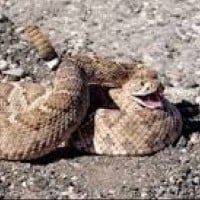 A venomous snake species native to the southeastern United States, the Diamondback Rattlesnake is known for the diamond-shaped pattern on its back. It possesses a rattle at the tip of its tail, which is used to warn potential predators. It primarily feeds on small mammals and birds.
A venomous snake species native to the southeastern United States, the Diamondback Rattlesnake is known for the diamond-shaped pattern on its back. It possesses a rattle at the tip of its tail, which is used to warn potential predators. It primarily feeds on small mammals and birds. In the rattlesnake family, this snake's bite packs a serious punch.
It delivers venom in such a high dosage that damages tissue, membranes, blood cells, and causes, you guessed it, pain.
It induces severe radiating pain that victims described as having a blowtorch burn inside their flesh or being branded with a hot poker that doesn't get released.
It's bite causes severe pain, extreme swelling, internal/external bleeding, profuse sweating, dehydration, dry mouth, and in some cases, necrosis, cardiac arrest, and if not treated properly, death.
It's something you do not wanna mess with.
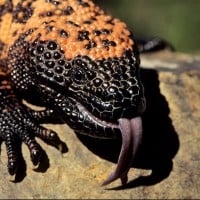 The Gila monster is a species of venomous lizard native to the southwestern United States and northwestern Mexican state of Sonora.
The Gila monster is a species of venomous lizard native to the southwestern United States and northwestern Mexican state of Sonora. These are one of the most venomous lizards in the world.
The name gila is Indian for crazy.
It's delivers venom passing around its teeth onto its prey, and human victims are typically latched on by it for 10 minutes.
Yet one famous incident happened when YouTube wildlife star Coyote Peterson got too close for photographing it, leading to the bite, which despite lasting only a split second, delivered unbearable pain he described as hot lava going through his bloodstream.
Yet he admitted the pain lasted for 8 hours before subsiding and that the treatment is to ride it out.
Deaths from it are rare though, but it's important to know they are defensive and won't hesitate to bite or deliver it's extremely unbearable pain.
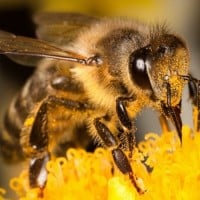
Honeybees are the most common species of bees, there are types known as Western honeybees (apis mellifera) and Asiatic honeybees (apis cerana), along with Africanized killer honeybees (apis mellifera scutellata lepeletier).
They're known for their striped fuzzy pattern, and they make honey by drinking nectar with their proboscis and regurgitating as many times till it's good to go.
Which means honey is nectar in the form of vomit, which sound gross.
But despite that, it's useful for many people and helpful in nature.
There's hive of bees, containing worker bees, drone bees, and the queen bee, the largest type of honeybee, measuring 1.5" long.
Their sting is intermediately painful, but a lot of people try to stay away from these things, except for beekeepers, who have the balls and guts to work with them and help them.
A sting from it contains venom with phospholipase and melittin, which is a cytotoxin, meaning it breaks down blood cells and the membranes around them as well as clotting, yet contains enzymes, amino acids, along with apaman and peptides, all of which burn tissue, leading to wounds.
Yet it contains cardio toxins, which destroy cells in the heart, meaning each bee sting raises your risk of cardiac arrest.
Yet that and how common honeybees are along with the risk of allergic reaction are reasons why honeybees are the 2nd deadliest insects ever known to man only behind mosquitoes.
Along with the fact that their stingers are barbed, so they rip off the bees and stick onto skin, continuing to pump more venom onto the victim.
Yet entomologist Justin Schmidt used the honeybee as a reference of comparing other stings, and ranked it as a 2, describing the western honeybee as this: Burning, corrosive, but you can handle it, a flaming match head lands on your arm and is quenched first with lye and then sulfuric acid".
Which is downright scary, and the Asiatic honeybee is also... more
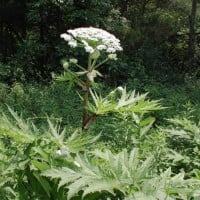
This shouldn't be on here because hogweeds don't bite or sting, but instead are covered in chemicals that make you extra sensitive to sunlight and ultraviolet radiation, causing a reaction known as phytophotodermatitis, which is basically an extreme sunburn.
Now don't put poison ivy, oak or sumac on here either because those don't bite or sting either, but are covered with an oily substance known as urushiol, which commonly causes an allergic reaction called allergic contact dermatitis to those in contact with them.
Stinging nettles do sting though as they have spines that inject venom onto victims, mainly consisting of formic acid.
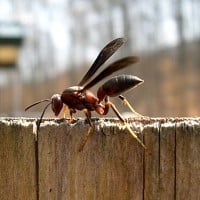
The polistes metricus is known as the metricus paper wasp.
It's dark brown with red spots, and eats wood to be put onto their saliva so they can make nests.
A sting from one is a 3 and causes pain that lasts up to 15 minutes.
Update: now this is 12, it should be lower because its sting is not more painful than that of a bullet ant, which is also incorrectly placed at 13, the giant desert and Amazonian giant centipede, fire coral, platypus, stingray, stonefish, box jellyfish, flannel moth caterpillar, and the gympie gympie, those are WAY worse than this.
This list is seriously messed up.
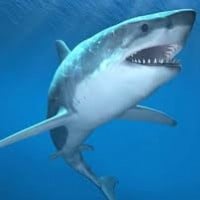 Sharks are a group of elasmobranch fish characterized by a cartilaginous skeleton, five to seven gill slits on the sides of the head, and pectoral fins that are not fused to the head. Modern sharks are classified within the clade Selachimorpha (or Selachii) and are the sister group to the rays. However,... read more
Sharks are a group of elasmobranch fish characterized by a cartilaginous skeleton, five to seven gill slits on the sides of the head, and pectoral fins that are not fused to the head. Modern sharks are classified within the clade Selachimorpha (or Selachii) and are the sister group to the rays. However,... read more Shark bites are extremely forceful as they cut their razor teeth through our muscles, and even our bones would be sliced.
Bites though are extremely rare.
My cousin got his leg bit off by a shark. He was surfing and it bit him. It was so bloody. He's still alive, but he has one of those fake legs now.
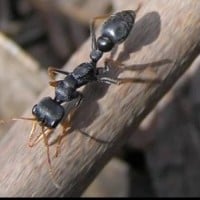
The myrmecia pilosula are famous in Australia for jumping and they have a bad reputation for causing allergic reactions in victims.
Their sting was ranked by Justin Schmidt as a 2 and described as "the oven mitt had a hole in it when you pulled the cookies out of the oven".
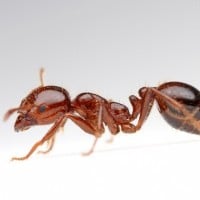
The solenopsis invicta are a member of the species solenopsis, a member of the genus myrminicae, and they're the most famous species of fire ant species, and have spread around the world by human commerce, worldwide.
They usually invade open areas, but can easily colonize human structure and agricultural systems, such as coffee and tea.
They were described by entomologist Felix Santschi as a variant in 1916.
They're named fire ants because not only do they look red like fire, but they have a somewhat mean sting and when swarmed together, they constantly sting victims, creating a painful sensation resembling fire, yet they release an alarm pheromone that allows others to sting the person, significantly increasing the pain and even increasing the possible risk of infection.
When entomologist Justin Schmidt was stung by just 1 solenopsis invicta, he ranked it a somewhat mild, but noticeable 1.2, and described it as "sharp, sudden, mildly alarming, like walking across a shag carpet and reaching for the light switch" when he meant by walking on a soft carpet with static electricity, which can interrupt your morning walking out of bed.
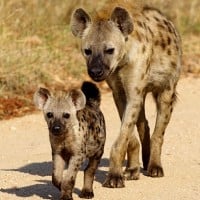 Hyenas or hyaenas are any feliform carnivoran mammals of the family Hyaenidae /haɪˈɛnᵻdiː/. With only four extant species, it is the fifth-smallest biological family in the Carnivora, and one of the smallest in the class Mammalia.
Hyenas or hyaenas are any feliform carnivoran mammals of the family Hyaenidae /haɪˈɛnᵻdiː/. With only four extant species, it is the fifth-smallest biological family in the Carnivora, and one of the smallest in the class Mammalia. They roam through deserts, and even sneak up on campers, even at the least expected time, and bite them with extreme force repeatedly, causing extreme damage, and you guessed it, pain.
Plus, they do it until the victims are dead until they eat them to prevent injuries to themselves.
They often bite people's faces and eat the soft tissue, then the mouth, breast and the groins.
 Found in Southeast Asia, this small primate is notable for its slow movements and distinctive facial markings. It possesses a gland near its elbows that secretes a toxin, which it can spread through its bite. Due to its cuteness, it is unfortunately often illegally traded as a pet.
Found in Southeast Asia, this small primate is notable for its slow movements and distinctive facial markings. It possesses a gland near its elbows that secretes a toxin, which it can spread through its bite. Due to its cuteness, it is unfortunately often illegally traded as a pet. To make matters worse, they also happen to have a venomous bite.
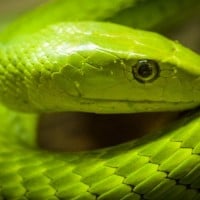
It's a mamba that's green and has a venomous bite with extreme burning pain radiating through and causing respiratory problems and dropped blood pressure, along with sweating, and if not treated properly, death can occur.
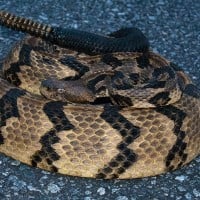
Like all vipers, this snake delivers a potent bite with powerful venom and causes severe pain, extreme swelling, internal/external bleeding, profuse sweating, dehydration, dry mouth, and in some cases, necrosis, cardiac arrest, and if not treated properly, death can occur after a bite.
If you see a venomous snake, be wise and keep a safe distance and don't provoke fear as that'll only trigger it.
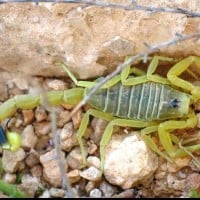
The most venomous scorpion of all, the deadliest too.
Human fatalities were reported with these stings, not to mention their stings are incredibly painful yet scary, and the death stalker lives up to its names.